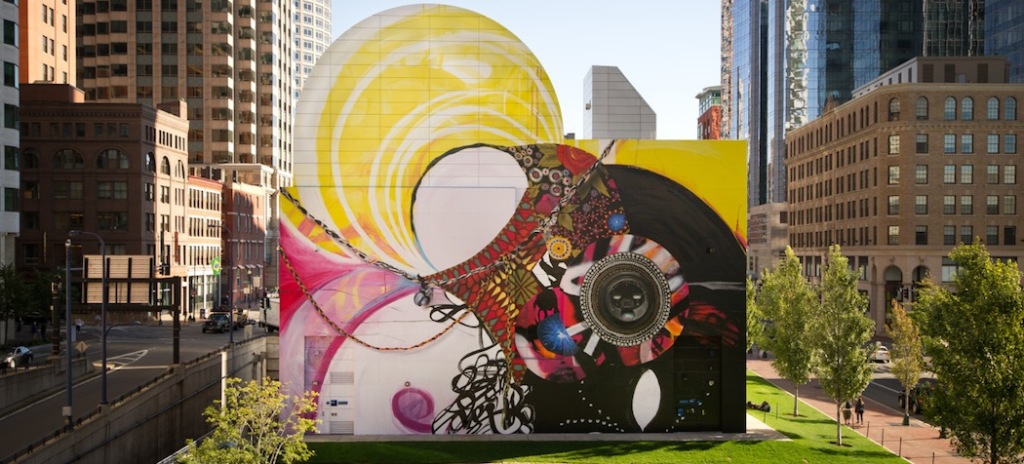This Boston Globe article highlights the rising role of the actor-playwright in the Boston theatre scene and asks these actors why they have decided to pursue writing in addition to their acting careers. C1 artists Obehi Janice (FUFU & OREOS, Splendor), Steven Barkhimer (The Book of Grace), and Danny Bryck (No Room for Wishing) are interviewed and/or featured in this article. Full text is below.
At 55, Steven Barkhimer is one of Boston theater’s most familiar faces, with scores of local productions under his belt in the past decade-and-a-half. At 26, Obehi Janice is near the beginning of her acting career.
But Barkhimer and Janice have one major thing in common: Each has chosen not just to perform in plays, but to write them as well. “Windowmen,’’ Barkhimer’s comic drama about shady doings at the Fulton Fish Market in the early 1980s, recently wrapped up a critically acclaimed run at Boston Playwrights’ Theatre. “FUFU & OREOS,’’ Janice’s semi-autobiographical solo show, is slated for a workshop performance at Company One Theatre in June, and she is currently at work on a couple of full-length plays.
They are members of a robust and crowded category, in Boston theater and beyond: the actor-playwright, or, in some cases, the playwright-actor. These multitasking hyphenates are an especially welcome presence in the theater just now. At a time when technology and spectacle are increasingly in vogue onstage, the actor-playwright can help remind us that the play’s the thing — to borrow a line from an actor-playwright of note, William Shakespeare — and underscore the fact that a compelling story is the most special effect of all.
After all, who knows better the electric power of the spoken word than the performers who speak it night after night onstage? And who has a bigger professional stake than actors when it comes to keeping the theatrical pipeline stocked with plays that are rooted in complex, multifaceted characters who can talk up a storm?
Though actor-playwrights of course write in different styles and genres, plays written by performers help strengthen the tradition of psychological and social realism, which is, after all, at or near the top of the list of things the American theater has historically done well: O’Neill, Miller, Williams (poeticized though his realism was), Mamet (stylized though his realism is). Pungently memorable dialogue is a hallmark of some of the better-known actor-playwrights, such as Sam Shepard, Anna Deavere Smith, and Tracy Letts, author of “August: Osage County’’ and a Tony Award winner for his performance in “Who’s Afraid of Virginia Woolf?’’ Generally speaking, their works are driven less by image than by character and story and psychological atmosphere.
Firmly in that tradition is the Pulitzer-winning “Clybourne Park’’ by actor-playwright Bruce Norris, seen last season at SpeakEasy Stage Company. Norris’s play shone a merciless light on the way language conceals and reveals when the subject is race. “Clybourne Park’’ also provided a showcase for the SpeakEasy cast, who got to play different roles in each of the play’s two acts, in eras half a century apart, while immersed in the kind of high-stakes confrontations that are any actor’s dream.
Language is also central to Barkhimer’s “Windowmen,’’ a portrait of blue-collar workaday reality that manages to be both hard-nosed and heartfelt while featuring a host of gritty, profanely eloquent characters. A couple of them — such as Al, the gruff and intimidating owner of Turner Point Fish Company — are more complicated than they first appear. All of them operate within a moral universe that is streaked with shades of gray; there are personal pressures, Barkhimer’s play suggests, that might tempt a fundamentally decent man to cross the line into criminality.
We learn a lot about the byzantine workings of a New York fish market in “Windowmen,’’ whose most distinctive character is Vic, a vendor from Brooklyn whose staccato soliloquies and rapid-fire transactions with buyers of flounder and grouper — conducted in an arcane code — are a marvel to behold: “Got three-seventy-five at 1-4-5, that’s five four three seventy-five, ba-boom!’’ he barks through the customer window at one point. “All right, Tommy, see ya tomorra!’’ Vic is a one-man assembly line, simultaneously training a college-educated new employee named Ken, quizzing him on his living situation and love life, and dealing with a nonstop blizzard of customer requests. It’s the kind of matter-of-fact multitasking not often celebrated onstage. In letting us see what the vendors do, Barkhimer enables us to also see who they are.
Voluble though the characters are in “Windowmen,’’ much is left unspoken as the central story line unspools, or spoken of only in the most cryptic, fragmentary terms. In a telephone interview, Barkhimer makes clear that approach is a direct result of his experience as an actor.
“I understand the temptation to overwrite things so that people get it, but what actors are good at is unpacking the suitcase,’’ says Barkhimer, who lives in Brookline. “The actor is your collaborator, and to know that when you’re setting pen to paper — ‘Don’t put this in, I’m sure the actor will find it’ — you have that trust so you can subtract things and know they will find the emotional interior, the subtext. Having found enough subtext myself [as an actor], I perhaps know not to spell it out, to leave that out there for the actors and directors to do it themselves. To write with a kind of trust.’’
Of course, it’s easy to write with trust when you know that you’ll be the one performing the play you’re writing. “FUFU & OREOS’’ grew directly out of Janice’s experience as the daughter of Nigerian immigrants. “I didn’t see that story, so I wrote it myself,’’ she explains. “It encompasses my identity and the duality of being American and being Nigerian, of how strong your family ties are, being this multicultural person but also being an American, dealing with the balance of that.’’
With regard to acting and writing, Janice says: “I feel like I have both hats on at the same time. They don’t feel separate. More actors should be writing, either as an exercise or to explore that part of ourselves more. You just learn things about yourself. What I learned is that I am more than enough. All I did was listen to that tiny voice saying ‘You should write that down.’ ”
A striking number of theater artists in the Boston area have listened to that tiny voice and donned those two hats at one time or another. In addition to Barkhimer and Janice, a list of those who have both acted in and written plays would include Melinda Lopez (“Sonia Flew’’), John Kuntz (“The Hotel Nepenthe’’), Ryan Landry (“Mildred Fierce’’), Walt McGough (“Priscilla Dreams the Answer’’), Robbie McCauley (“Sugar’’), Brenda Withers (“The Billingsgate Project’’), Benjamin Evett (who collaborated with Barkhimer on “Blood Rose Rising’’), and many others.
“The playwright may ultimately enjoy a deeper kind of satisfaction,’’ says Barkhimer. “To have written a piece and have the audience laughing and responding, that’s very satisfying, I’ve got to say. Maybe it’s one degree more separated from the evanescence of performance. As an actor you walk off and go ‘All righty, well, that’s done.’ But the play [you’ve written] has legs of its own.’’
On the most basic level, of course, writing plays can be an act of simple self-preservation for actors. You can literally script a part for yourself, as Kuntz did with “The Salt Girl,’’ an ambitious 2009 solo play about a man (portrayed by the author) who is coping, not very well, with the psychological fallout of his sister’s disappearance during childhood.
Any actor who cares about the art form wants to have some say over the shape of theater in our time, the direction it takes in the future, the values it chooses to champion. There’s nothing wrong with video projections or aerial stunts or life-size puppets as a means to storytelling, but actors who write can be a force that safeguards the theater from conceptual gimmickry run amok. The holographic horse that galloped across the stage of the Cutler Majestic Theatre in December 2012 in “La Belle et La Bete’’ was very impressive, but the script by Pierre Yves Lemieux was almost unlistenable.
Experienced actors can write with an intuitive grasp of, say, when the pace of a play needs to be accelerated or slowed down, or when the audience’s perspective on events needs to be shifted, or when the emotional or psychological stakes for Character X need to be made clearer. Because performers often become personally invested in the communities where they live and work, actor-written plays can have a sense of place that anchors their work in the here-and-now, quite literally, and that reflects their communities more fully than dramas imported from New York or elsewhere. Boston actor Danny Bryck conducted scads of interviews with protesters at Occupy Boston, then turned those interviews into “No Room for Wishing,’’ a documentary solo play in which he played dozens of characters and captured a slice of regional history.
At Trinity Repertory Company in Providence, artistic director Curt Columbus sees so much merit to the actor-playwright model that one of his first steps when he arrived eight years ago was to implement a program in which members of the company’s resident acting ensemble are encouraged to write plays, with a commitment from Trinity Rep to stage them once they’re ready for production. In 2011, ensemble member Stephen Thorne’s “The Completely Fictional — Utterly True — Final Strange Tale of Edgar Allan Poe’’ received its world premiere at Trinity Rep.
“All I did was listen to that tiny voice saying “You should write that down,” said Obehi Janice, actor-playwright.
“As a playwright, I have been extremely frustrated by the play development process in this country, because you never know for what community of artists or community of audience you are writing,’’ Columbus says in an e-mail. “Shakespeare, Chekhov, Moliere, Odets, and many, many more, wrote for specific artists and specific communities, and found universality through that process. We have been trying to reclaim that impulse with our program.’’
Beyond enriching the tapestry of stories that get told, an actor can also gain a deeper connection to, and understanding of, his or her chosen profession by writing plays. Playwriting can potentially open up a second revenue stream for perennially impecunious actors — granted, not much of a revenue stream; this is theater we’re talking about — while expanding their personal brands. For someone who is starting to build a career in the theater, such as Janice, embracing the dual identity of actor-playwright just might be a way to cushion some of the inevitable blows of a pitiless profession and not feel helpless, subject to the whims of others.
“The writing and the acting together, it’s definitely a force, a combined force that helps me create my own path,’’ says Janice. “Auditioning is a really rough part of being an actor. It’s so humbling and so frustrating. But then I get to have my writing to balance that out. I think about it less as ‘I’m a bad actress’ than ‘I just wasn’t right for the role.’ When you’re a writer you just realize that you can’t take rejection so personally.
“I feel if I’m not in a play right now, that’s OK,’’ she adds. “Because I’m writing.’’


